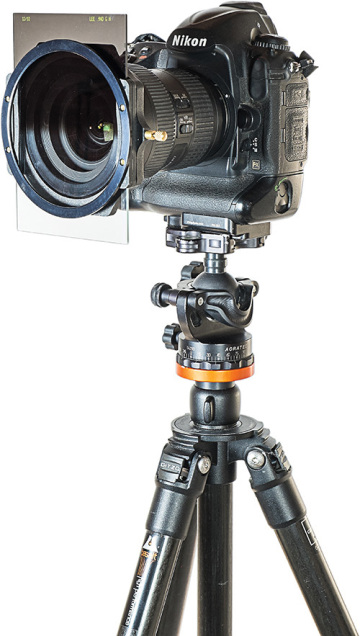A LOT OF TOOLS ARE AVAILABLE that can change the way you make photographs and the way your photographs look. Flash is one of them, but you won’t find me teaching about it for two reasons. The first is that I don’t use flash myself. It’s just a preference, so teaching how to use it would be hypocritical of me. The second reason is that others can, and do, teach about flash lighting—Joe McNally and Syl Arena being among the most qualified I can think of—and I’d rather defer to them. So if portraits and artificial lighting are your thing, then consider this your permission to go on a field trip. I think understanding this lesson about optical filters is still important, but it does apply most specifically to photographers working with landscapes and outdoor scenes. So if that doesn’t do it for you, take your flash out and play. Pick up one of Joe’s books (especially The Hot Shoe Diaries) if you use Nikon, and Syl’s book Speedliter’s Handbook if you use Canon. They use flash for their work for the same reason I use optical filters for mine—different tools change the way we work, open new possibilities, and do things for the photograph that Photoshop, for all its wonders, can’t easily do, or do at all.
In the case of optical filters, the argument that they’re no longer needed doesn’t fly with me. The effect of some optical filters can, absolutely, be replaced with digital darkroom work. There are times I will use a three-stop graduated ND (neutral density) filter for landscape work, even though I know I could do the same in Lightroom, and with greater control. Why? Because I don’t just make one image, then move on. I look at my sketches, react to them, and make changes to my composition or exposure based on what I see. I don’t visualize the final image very well, and filters help my process. And I can still make several frames without the filter so I’ve got an unfiltered, blank-slate image to work with later in Lightroom if I desire. So that’s one reason. Filters help my process even when I don’t need them.
The other reason is that not all filters can be reproduced later with software. There are three optical filters that create effects that can’t always be reproduced, and you’ll benefit from being familiar with them: the circular polarizer; the neutral density filter; and the graduated, or split, neutral density filter. Look at the work of some of your favorite landscape photographers and you’ll see images they couldn’t have made without one of these—or all of these—filters. Like any of photography’s tools, they are no substitute for vision, moment, light, and creative composition, but if you’ve got those, these filters can mean the difference between a good image and one that goes up to 11.
The circular polarizing filter acts like polarizing lenses on a good pair of sunglasses—the lens, when rotated, filters out polarized light. Depending on conditions, practically this means darker skies, less reflections, and deeper, more saturated colors. Used well, it can turn a shimmering river from a ribbon of silver into a ribbon of darker tone, which can entirely change the way the eye reads the photograph. You could use Photoshop to make skies more dramatic or colors more saturated, but not to pull the shine off wet leaves.
In use there’s not much to it. They work best when aimed perpendicular to the sun, but can do wonders even under overcast skies. Turn the circular polarizer on the front of the lens to gain maximum effect. Be careful with ultra-wide lenses, since they can capture such a broad expanse of sky that some of the sky is filtered more than other parts (the less perpendicular the sky is to you, the less the effect), and weird banding can occur. With my polarizer, as with my other filters, I make a practice of creating a safety frame or two without the use of the filter, just in case I prefer the scene without its effects. Options keep possibilities open, and it’s very hard to un-polarize a weird patch of sky that went too dark because I wasn’t paying attention.

Leica M (240), 21mm, 31 seconds @ f/4, ISO 400, polarizer
Taken only a couple minutes apart, both with a full and graduated ND filter, the only difference is that one uses a polarizer and the other doesn’t. Conventional wisdom says to use a polarizer on water, but in this case doing so removes the very reflections I love about the scene. Make filter choices based on what you want the photograph to look like, not what others tell you.

Leica M (240), 21mm, 0.7 seconds @ f/11, ISO 100, no ND filter
Neither is better than the other. Each interpretation of this scene in Newfoundland says different things. Both are beautiful, I think, but one is much more about the relationship between the rock and the cliff, and the other is about the rock, cliff, and pounding surf.
The neutral density (ND) filter has two characteristics. The first is that it’s neutral—without a color cast. In reality, few are perfect, and many add a slight magenta hue to images, though that’s easily corrected. The second is that they are, well, dense. They cut light. When you can’t drop your ISO any further, close your aperture any tighter, or make the shutter any faster, a neutral density filter cuts the light. I have filters that can cut the light by up to 11 stops in my bag. That’s enough to turn a 1/30-of-a-second exposure into a 30-second exposure. Why would I want to do this? To compound the effects of time. You might want a photograph of a scene without people in it. At 1/30 of a second, it’ll be a while before you get one clean shot. At 30 seconds, assuming everyone is moving, they turn into invisible blurs, and at 3 or 5 minutes, you won’t see a thing. The same is true of clouds, turning them into long wisps that blend into each other, or water, churning it into placid lakes or even ghostly vapor. A 10-stop ND filter is hard to use for portraits, but a 3-stop ND might be just enough for you to open that 85mm f/1.2 lens up in bright sunlight and make use of that dreamy shallow depth of field.

Leica M (240), 21mm, 1/3 @ f/13, ISO 400
I shot this with a three-stop graduated ND filter, and simulated, in Lightroom, what it would have looked like without filtering out those three stops of light. The filter allows me to balance the exposure and keep the foreground bright, while not losing the detail and impact of the sky to overexposure.
The graduated ND filter is a neutral density filter that fades from full strength, usually 1–3 stops, to clear, in either a smooth slow transition or a hard transition. The advantage here is that the filter blocks light in one part of the scene while allowing full exposure in another. So if you’re photographing a golden prairie under a bright sky, you might find it hard to expose for the sky without the prairie being too dark to see the color and detail, or to expose for the prairie without the sky becoming too bright and losing all detail and mood. But if you put a graduated ND filter in front of your lens and place the transition on the horizon, you can expose for the prairie, keeping it bright and full of detail, while also keeping the sky moody. You could, of course, use the filter at any angle, or upside down, to darken a foreground and keep a background light, as long as your scene has a relatively straight, uninterrupted horizon. You can still use these graduated filters when the horizon is interrupted, for example, with a mountain or tree, but you’ll probably want to work on that later with software, selectively brightening that element to match the rest of the foreground.
One final word about the graduated filters. I don’t find one-stop filters to be of much use. Even two-stop filters rarely make it into my bag. But I carry both a hard-transition three-stop and a soft-transition three-stop. When the horizon is really irregular, I use the soft transition. But your choice of aperture also has an effect on how hard the transition is, in both cases, though more noticeably in the case of the hard transition. If you close your aperture, deepening the depth of field, the transition will become more noticeable. Sometimes you might want this, but if you don’t, keep the aperture wider and it’ll keep the transition softer and less noticeable. The same applies if you have light scratches on the filters, which will happen over time. A deeper depth of field will make those scratches more noticeable.
You can find a lot of different filters out there, and it’s a little tough to get your mind around all the options. My recommendation as I write this is to look into the Lee Filter System with either Lee or Singh-Ray filters. You buy different rings to fit the thread on different lenses, onto which a larger, plastic filter folder fits. Into this you can stack a couple square or rectangular filters—I often stack a graduated ND filter with a full ND filter, allowing me to knock the sky back as well as increase the length of my overall exposure, deepening twilight blues, ghosting clouds, or smoothing ocean. On top of that, a ring is available, which screws onto the front of the filter holder, onto which you can place a large polarizer. The advantage to this system is that you buy one filter—the most expensive part—only once, instead of one for every lens with a different thread size. The filters aren’t cheap—quality usually isn’t—but if you take care of them and don’t scratch or drop them, you’ll have them for a while.




